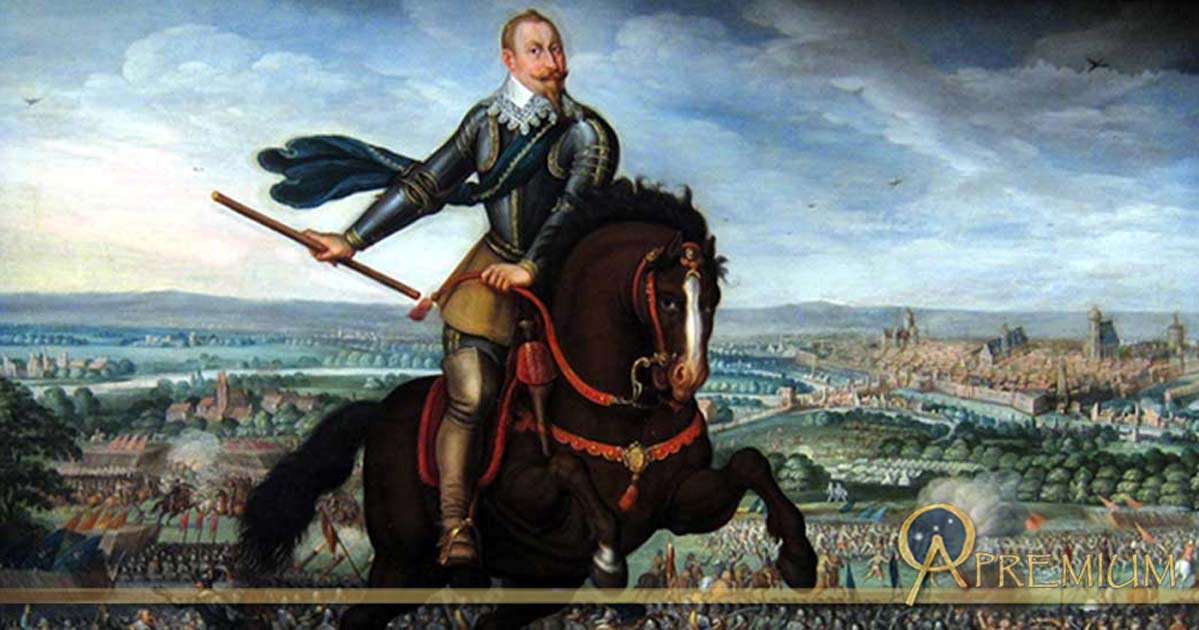“Lion of the North” Gustavus Adolphus and the Thirty Years’ War: Fighting the Holy Roman Empire – Part I
On 9 December 1594, Gustav II Adolf was born. From the time of his birth until his coronation, his upbringing involved many lessons in politics, literature, military science, and physical development, making him physically and intellectually rounded. In 1611, his father, Charles IX of Sweden died, leaving the Swedish crown to the young Gustav who was sixteen at the time.
When Gustav was crowned king of Sweden, there was no celebration for the sixteen-year-old had inherited from his father three bloody wars against Denmark, Russia, and Poland, along with financial troubles. However, the boy king would not let these incredible challenges stop him from restoring stability to Sweden and leading his country towards military innovation and glory.
This is the recounting of the dramatic life of the “The Golden King” and “The Lion of the North” Gustav Adolf and the Swedish Empire during stormaktstiden – “the Great Power era”.
Gustav Enters the War
In 1629, the Holy Roman Emperor Ferdinand II of Bohemia made a drastic move without consulting the electoral princes, his advisors, and the imperial diet as a whole when he announced the Edict of Restitution. This edict took 500 abbeys, two archbishoprics, and two bishoprics that had been "secularized" since 1552 by Germany princes and returned them back to the Catholic Church.

Ferdinand II of Habsburg, Emperor of the Holy Roman Empire, King of Hungary and Bohemia with his court dwarf. (Public Domain)
This not only threatened the Protestant princes who sized church land, but indicated how far the emperor would go with his authority at the expense of his own subjects. Ferdinand’s expanding sphere of influence not only threatened the Protestant authorities within his realm, but also Sweden, for they shared a presence on the Baltic, which eventually induced Gustav to invade Germany.
Before Gustav could set off for war against the Holy Roman Empire, he needed to calculate the costs of the war and the amount of supplies the army would need. Upon examination, the Swedish exchequer concluded that it would cost the taxpayer 2,800,000 silver dalers. While the money was being carefully calculated and banked, the spending started immediately to pay the producers to manufacture the supplies and an army to use them. To get an idea of the amount of supplies needed, an infantry regiment of 576 muskets would need 3,000 pounds of gunpowder, 2,400 pounds of lead, and 3,400 pounds of match each month while campaigning.
Early spring 1630, Gustav mustered 13,641 soldiers and placed them to a fleet consisting of 25 major warships along with 75 smaller units and transports. With troops assembled, they boarded the ships.

The Vasa, early 17th century warship, was ordered by King Adolphus and built at the Stockholm shipyard by Henrik Hybertsson - an experienced Dutch shipbuilder. Vasa was to be the mightiest warship in the world, armed with 64 guns on two gundecks. (Dennis Jarvis/CC BY-SA 2.0)
However, the winds were unfavorable, and it took the fleet a little longer than hoped to arrive. On June 25, the Swedish forces quickly disembarked at Peenemunde, which is located on the northern end of the island of Usedom, sent reconnaissance parties out, built field fortifications, and began sweeping the island clean of enemy forces. By July 4, the island was under Swedish control. With a base established, the Swedes could now receive supplies and troops and when news reached the German interior that Gustav had arrived, the Protestant powers of Europe, such as the elector Palatine and Landgrave (Duke) of Hesse-Cassel, saw opportunity arriving…
This FREE PREVIEW is just a taste of the great benefits you can find at Ancient Origins Premium.
Join us there ( with easy, instant access ) and reap the rewards: NO MORE ADS, NO POPUPS, GET FREE eBOOKS, JOIN WEBINARS, EXPEDITIONS, WIN GIFT GIVEAWAYS & MORE!
MORE
- The Well-Preserved Wreck of the Formidable Warship Mars
- The History of the Incredible Vasa Warship and its Humiliating Shipwreck
- Christina, The Minerva of the North Who Abdicated Her Throne to Live Life by Her Own Rules
Top Image: The victory of Gustavus Adolphus at the Battle of Breitenfeld (1631) (Public Domain)
By Cam Rea




















